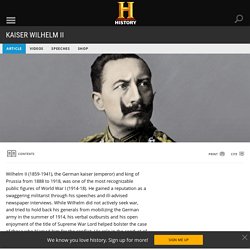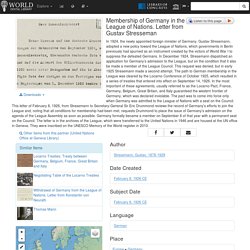

Kaiser Wilhelm II - SIMPLE. Kaiser Wilhelm II - CHALLENGING. Kaiser Wilhelm II was born in Potsdam, Germany, on January 27, 1859, the son of Prince Frederick Wilhelm of Prussia (1831-88) and Princess Victoria (1840-1901), the oldest daughter of Queen Victoria of England (1819-1901).

The future monarch was the queen’s firstborn grandchild and was genuinely fond of her; in fact, he was holding her in his arms when she died. His ties to Britain through its royal family would play an important part in his later political maneuvering. Wilhelm’s childhood was shaped by two events, one medical and one political. His birth had been traumatic; in the course of a complicated delivery, the doctor permanently damaged Wilhelm’s left arm. In addition to its smaller size, the arm was useless for such ordinary tasks as cutting certain foods with a knife at mealtime.
The political event that shaped Wilhelm was the formation of the German Empire under the leadership of Prussia in 1871. Kaiser Wilhelm II - VIDEO. Imperial Germany - scroll to the bottom for 5 key points. Key Topic 1 Quiz: The origins of the Weimar Republic, 1918–19. Map of the Treaty of Verailles. Video with more detail on the Treaty of Versailles and Germany. Key topic 1.2 & 1.3 Quiz. Stresemann Years of Weimar Republic 1923-1929.
GCSE Bitesize - Weimar - strengths and weaknesses. Hyperinflation 1923. GCSE Bitesize - Germany 1918 - 1939. Weimar Germany. The Golden Years of the Weimar Republic. The Young Plan 1929. The Young Plan 1929 The Dawes Plan had attempted to deal with the massive inflation and large-scale unemployment in Germany that had been caused by reparations ordered as part of the Treaty of Versailles.

However, the German government continued to complain at the level of reparations. In 1929 the Allied Reparations Committee asked an American banker, Owen D. Young, to investigate the situation. The Young Plan It suggested that reparations should be reduced by about three-quarters and that Germany should make annual payments on a sliding-scale up to 1988. The Young Plan was a considerable achievement for Stresemann. The plan came into effect when Germany felt the full impact of economic depression and a moratorium was called for the fiscal year 1931-32. Germany joins the League of Nations 1926. In 1924, the newly appointed foreign minister of Germany, Gustav Stresemann, adopted a new policy toward the League of Nations, which governments in Berlin previously had spurned as an instrument created by the victors of World War I to suppress the defeated Germans.

In December 1924, Stresemann dispatched an application for Germany’s admission to the League, but on the condition that it also be made a member of the League Council. This request was denied, but in early 1925 Stresemann made a second attempt. The path to German membership in the League was cleared by the Locarno Conference of October 1925, which resulted in a series of treaties that entered into effect on September 14, 1926. In the most important of these agreements, usually referred to as the Locarno Pact, France, Germany, Belgium, Great Britain, and Italy guaranteed the western frontier of Germany, which was declared inviolable. Homework: Did the position of women improve in the Weimar Republic.
Key topic 1.4 Quiz: Changes in society,1924–29. 1.1 The War Ends. 1.1 The Weimar Republic. 1.2 Challenges to the Weimar Republic. 1.2 Unpopularity of Weimar Republic 1919 1923. 1.3 Recovery under Stresemann. 1.4 Life Imrpoves in the Weimar Republic.